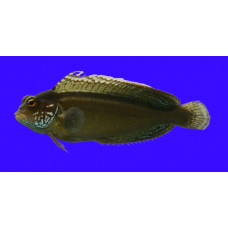Latin name
Cirripectes castaneus
Other name
Cirripectes castaneus
Identification
Chestnut eyelash-blenny: 29-31 vertebrae; body depth at beginning of anal fin 3.2-3.5 inches wide; body depth at beginning of anal fin 3.2-3.7 inches, without scales or scaly shields; tubes 1-13 (usually 3-12), canal ends below 5th dorsal ray to base of caudal fin. Lower lip smooth at center, folded at sides. Upper lip teeth 29-50. Gill stamens 20-32. System of sensory pores on head simple; 1 pore behind each occipital lobe. Cirri, nuchal 29-44, nasal 6-49, supraorbital 6-49; nuchal cirri in 4 groups, the most ventral groups on each side located on slightly expanded occipital flap.
Features of fish fins
Dorsal spines (total): 11 - 13; Dorsal soft rays (total): 13 - 15; Anal spines: 2; Anal soft rays: 14 - 16. Membrane attached to caudal fin, with deep notch above last spine, first spine almost equal to or slightly higher than second.
Fish colouring
The coloration of this species is geographically variable. Males: Chagos, body stripes alternating light and dark brown, dorsal spine tips and anterior rays of caudal fin yellow; Red Sea, head and anterior body stripes narrow red on brown background; Great Britain, head and body stripes alternating pink and brown; Fiji, body stripes brown on gray or yellow background; Comoros, stripes reddish brown, slightly oblique. Females: mostly with reticulated pattern of wavy brown lines and pale polygonal spots; others have monotonous brown, especially from South Africa and Kenya, head with spots and lines; iris with irregular red ring around outer part of eye, narrow yellow ring around pupil and black between rings.
Distribution
Widespread in the Indo-West Pacific: from the Red Sea to Tonga, north to southern Japan; south to Lord Howe Island; Palau, Ifaluk and Kapingamarangi in Micronesia.
Habitat
A tropical marine species that prefers brackish water. Habitat depth range 0 to 32 m, usually 0 to 10 m.
Size
This species reaches a length of 12.5 centimeters (4.9 inches).
Behavior
Facultatively air breathing; adults live in algal thickets on outer reef shoals. Usually found on rocky and coral surfaces in small loose groups scattered in patches.
Food and feeding habits
It feeds mainly on algae. The fish's lower jaw bites into the algae while the upper jaw scrapes it off and sends it to the mouth.
Reproduction
Egg-laying. Eggs are benthic and adhesive, attached to the substrate by a fibrous adhesive pad or support. Larvae are planktonic organisms often found in shallow coastal waters. They have been collected at 30 m depth in the Red Sea and at 32 m depth on Rowley Bank off Western Australia. The urogenital opening of the male genital papilla is located basally between two widely separated thin fibers on a fleshy prominence behind the anus; the testes are convex, with a length equal to their width.
Fishing
This species is commercially important for fishing.
Relationship with a person
Harmless. Chestnut eyelash blennies are used in aquariums.
| Classification | |
| Phylum | Chordata |
| Class | Actinopterygii |
| Squad | Blenniiformes |
| Family | Blenniidae |
| Genus | Cirripectes |
| Species | C. castaneus |
| Features | |
| Conservation status | Least Concern |
| Habitat | Bottom |
| Life span, years | No information |
| Maximum body weight, kg | No information |
| Maximum length, cm | 12,5 |
| Sailing speed, m/s | No information |
| Threat to people | Edible |
| Way of eating | Algivore |
Chestnut eyelash-blenny
Tags: chestnut eyelash-blenny

